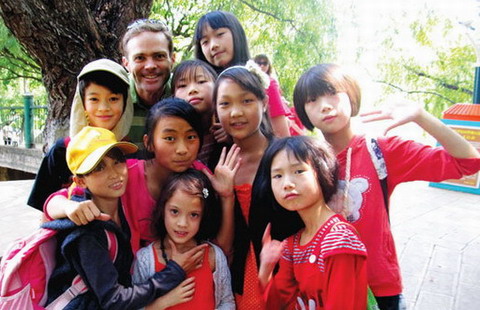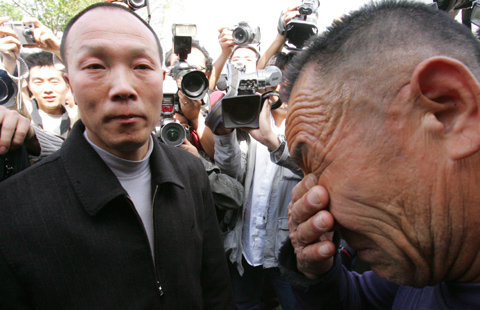
For Meshak Okoth, 12, this was a return to scholastic life like no other. When he returned in September to his studies with about 630 pupils at Mcedo-Beijing community school in Mathare, northeast of the Kenyan capital, the enthusiasm was palpable.
It had taken less than a month to give his school a spanking new look and a fresh feel. About 12 rooms had been built using steel beams and panels, materials and technology from China. They replaced rusty iron sheets that had provided rudimentary shelter to pupils for more than 10 years.
"It's just like Makini School," Okoth beamed as he surveyed one of the new classrooms, referring to a private school in a well-to-do neighborhood of Nairobi that is perennially among the top performers in national exams. With a fresh start and a clean environment there was no reason why the Mathare school could not emulate its rich counterpart, Okoth says.
|
Mathare residents enjoy their afternoon. Photos By Xie Songxin / China Daily |
Okoth, the only child of a single mother who works as a guard in one of many small security firms in the city, says the technology and know-how used to breathe new life into his school can be used to improve the lives of people living in the same kinds of rudimentary conditions.
He plans to become a structural engineer, he says, and in doing so he can bring such changes to his community.
Mathare is the second-largest slum in Kenya after Kibera. More than 500,000 people live in Mathare, and more are squeezed into an area of just 8 square kilometers, making it as tightly packed as some of the most densely populated cities on the planet.
One small consolation for those living in this teeming mass of humanity is that a new drainage system is being built in the area that will offer some relief from the squalor that is part of everyday life.
Okoth lives in quarters made of concrete that are sandwiched between houses made of sheets of iron.
"We have nowhere to play but outside, where we compete with the clogged and smelly sewers," he says.
"The new drainage system will be a relief."
That and other changes are easing the plight of those who live in Mathare, but these changes are happening at a snail's pace, residents say.
Claudio Torres Roje, an architect, urban planner and consultant for UN-Habitat, a United Nations agency that aims to improve urban housing, says Mathare exemplifies slums all over Africa, places where the main constant, decade after decade, is dirt and poverty.
One way of alleviating this is giving people security of property tenure or ownership, but putting that into practice runs into the problem of vested interests, Roje says, and implementing such initiatives has remained elusive.
"This has also resulted in a lack of motivation for change among slum dwellers. Based on what has happened in the slums of South America, it is clear that self-motivation is a vital element if living conditions on the ground are to improve. But in many cases in Africa people are afraid they will lose their living area if anyone comes in to carry out upgrading programs.
"A highway that leads to finally resolving this problem is still far off, but we can always take a side road that leads to improving the situation on the ground."
Various stakeholders need to be mobilized, rather than leaving it to dwellers and governments to reach agreements on their own, he says.
As urbanization continues in Africa, slums will continue to be part of the landscape as the growth of cities will require armies of cheap labor, who will be able to afford nothing more than slums as places to live.
Another problem besetting those who are keen to do something to alleviate the stress of slum dwellers is donor fatigue.
"You have to make an effort to be level-headed and sustainable economically, otherwise no one is going to want to deal with you," Roje says. "Some international organizations and donors that have traditionally supported slum alleviation projects have shifted their attention to other issues after receiving no sustainable results after years of investment."
That is not to say that poverty alleviation efforts have not had some successes in fields such as basic services including water and sanitation, education and health, but these tend to be meager. In Kenya, for example, while about 22 percent of slum households now have access to running water, 75 percent still depend on buying water from private vendors, many of whom charge extortion rates. In many of Kenya's slums, refuse collection is haphazard to nonexistent and only 10 percent of residents in some slums have proper sewerage.
In a strategy paper in May 2008, UN-Habitat called for innovative measures as the proliferation of slums continued to be fueled by what it called unsustainable urbanization.
However, Laila Macharia, chief executive officer of Africa Metro Group, an investment and advisory firm specializing in urban property and infrastructure, reckons that slums should be seen as a solution rather than a problem.
"They are landing ports for populations from rural areas so they need to be made bearable as people move into formal settings."
A little less than 62 percent of urban dwellers in Africa live in slums, a report by World Cities published last year said. The African country with the highest proportion of urban dwellers living in slums was Central African Republic, with 96 percent.
Historically in Africa, residential planning has been done in a hierarchal way, with space being distributed according to income. That means the rich having the most space. But this is quickly changing in tandem with new international concepts of urban development as people try to be more space sufficient, meaning density is considered desirable.
"More diverse neighborhoods are becoming trendy, where people of different incomes, age groups and skills live close together, making them vibrant, as opposed to what segregation does," Macharia says.
Cities are also becoming more thoughtfully planned as ideas that make comprehensive use of space are adopted. However, this calls for strong housing policies to redesign and redevelop existing plans.
"Addis Ababa has been successful on this front, unlike cities that already have stock like Nairobi," Macharia says, adding that with a determined government and an involved private sector things can change.
Expansion opportunities are rife in the suburbs, she says. New smart cities such as Tatu City and Konza in Kenya are emerging. Africa Metro Group has been appointed to head investor relations for Konza for the next five years.
"This is a smart city that has made provisions for upper, middle and lower income people," Macharia says.
Carefully crafted planning agreements involving the private sector can lead directly to slum upgrading, she says. Contracts can be designed to encourage companies to extend their corporate social responsibility to the local communities.
"When we seek a construction bid, location is irrelevant," says Wan Yongbin, executive project manager of Nanchang Foreign Engineering Company (Kenya), which is conducting the drainage project in Mathare.
The company won the contract from Athi Water, one of eight water boards under Kenya's Ministry of Environment. It is for a 54-kilometer drainage system, work on which has a total contract time of two years. Besides improving the health conditions in the area, local residents have been hired.
"As a construction company, we do not worry about the extreme working conditions," Wan says. "We believe that carrying out a project in a slum can set a positive image that gives us an advantage with future bids."
His company will bid on similar projects in the future, he says.
Macharia says "a comprehensive public-private partnership framework" is needed to attract private investors to such work. "A state may not need to spend but just oversee the project by having a proper legal framework and the right incentives."
This will ensure the project is not marred by controversies over land ownership and tenure, as is happening in Mathare. The drainage contract there is about to end, but the contractor is experiencing difficulty in gaining access to land in the last few kilometers.
In Kenya there is a national slum upgrading master plan but communities are always highly reticent about submitting space for development.
Community buy-ins are regarded as critical, and that is where non-governmental organizations such as Maji na Ufanisi (Water and Development) come in. The organization, set up 15 years ago, has heavily invested in social capital to ensure slum communities have a say in upgrading projects. The organization has previously worked in partnership with UN-Habitat and the World Bank. "We educate slum dwellers on how these projects can be economic vehicles toward improving their lives," says Edward Kairu, chief executive of the organization.
Among the projects the organization has overseen are seven water and sanitation projects in Kibera and a two-kilometer access road complete with lighting. That has resulted in fewer water-related illnesses. Security has also been improved.
Proceeds from these programs are pooled in cooperatives formed by the dwellers with the aim of buying land and accessing credit. About 200 households have been reached.
To address illegal electrical connections in informal dwellings, the state utility Kenya Power met stiff resistance when it tried to lay down infrastructure in Kibera.
"We mobilized the community and the project thrived," the CEO says.
The involvement of a community increases its sense of ownership and responsibility so such projects tend to be havens from crime even in areas with high levels of crime.
Benedict Kiage, the headmaster of Mcedo-Beijing community school in Mathare, says building materials were not plundered during the construction period. "Residents realized what benefits the school would bring to the community," he says.
The school is now able to expand its after-school programs. This is with the hope of attracting pupils who would otherwise engage in vices such as alcohol and drugs.
"We are creating a center of excellence that will translate to strong alumni who will later improve this community," Kiage says.
Since the school reopened, it has, for the first time, been used as a high school examination center, something Kiage is proud of and that he hopes will be repeated.
Contact the writers through lilianxing@chinadaily.com.cn
|
Benedict Kiage, headmaster of the Mcedo-Beijing School in Mathare. |
|
Meshak Okoth, a student at the Mcedo-Beijing School in Mathare. |
|
A child looks at passers-by in the heart of Mathare. Xie Songxin / China Daily |
(China Daily Africa Weekly 11/21/2014 page6)








